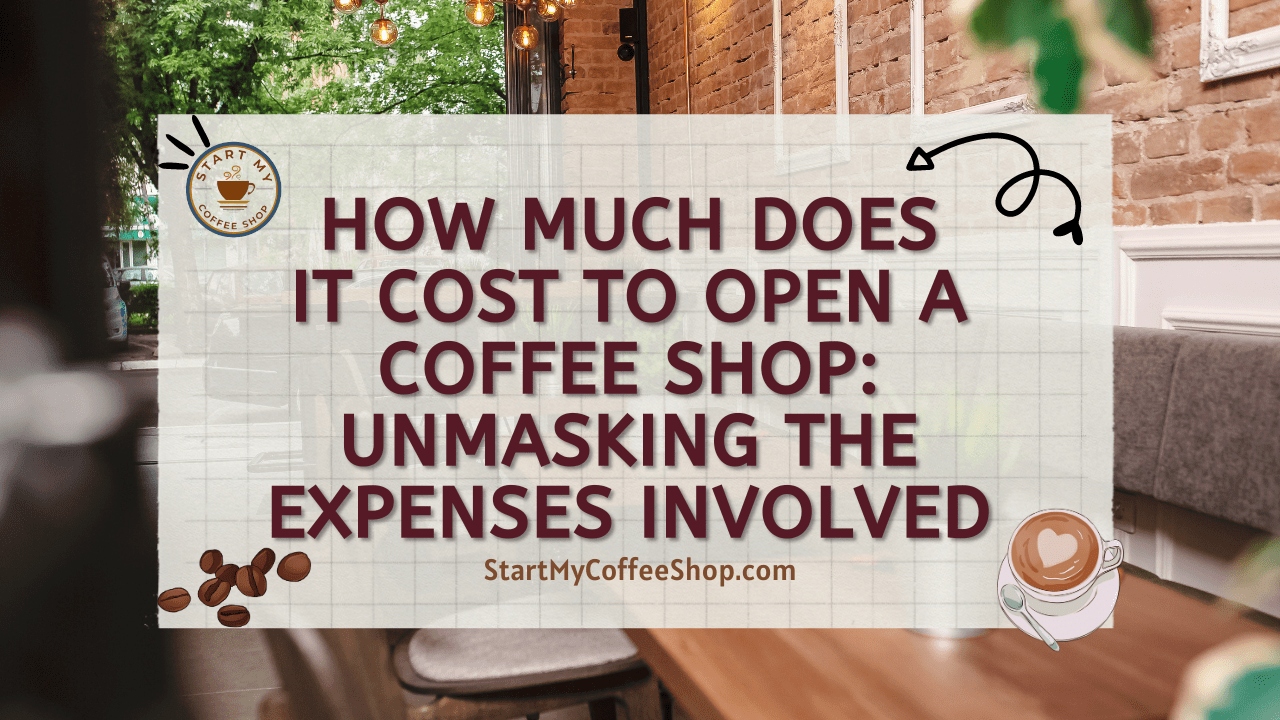Coffee shops have become cultural hubs, where people gather to sip aromatic brews, engage in conversations, and find solace in the comforting ambiance. If you’re considering entering the world of caffeine connoisseurs, it’s essential to understand the financial investment required.
The approximate costs to open a coffee shop include equipment, permits, staffing, and initial inventory. Expenses can vary, but typically range from $100,000 to $500,000, depending on location, size, and other factors.
In this article, I will delve into the intricacies of these costs, providing you with valuable insights to help navigate the journey of launching your coffee haven.
Location
 When embarking on the journey of opening a coffee shop, one of the first factors to consider is the location. The expenses associated with different locales can vary significantly, and careful consideration is essential to make an informed decision. Urban areas with high foot traffic and visibility often come with a higher price tag in terms of rental or lease rates compared to suburban or rural locations.
When embarking on the journey of opening a coffee shop, one of the first factors to consider is the location. The expenses associated with different locales can vary significantly, and careful consideration is essential to make an informed decision. Urban areas with high foot traffic and visibility often come with a higher price tag in terms of rental or lease rates compared to suburban or rural locations.
The allure of setting up shop in a bustling city neighborhood is undeniable. The constant flow of people passing by can potentially bring a steady stream of customers to your coffee shop. However, it’s crucial to weigh the benefits against the higher costs involved. These expenses can include higher monthly rent or lease payments, increased competition from other coffee shops, and potentially higher labor costs due to the local market conditions.
On the other hand, suburban or rural locations often offer a more relaxed atmosphere and the potential for a loyal customer base. The rental or lease rates tend to be more affordable, allowing for potential savings in operating costs. However, it’s important to carefully assess the demographic characteristics and target market preferences of the area.
Consider factors such as the population density, age groups, income levels, and lifestyle preferences of the potential customers in the vicinity. Understanding these demographics will help determine if there is sufficient demand for a coffee shop and if the location aligns with your target market.
Conducting thorough market research is crucial when selecting the ideal location for your coffee shop. Explore the local community, observe foot traffic patterns, and take note of nearby businesses, schools, offices, and other potential sources of customers. Additionally, consider the level of competition in the area. Are there already established coffee shops or similar businesses? While some competition can be healthy, too much saturation in the market might make it challenging to carve out a niche for your coffee shop.
Ultimately, finding the perfect location for your coffee shop involves a careful balancing act between costs, market demand, and competition. By analyzing demographics, studying foot traffic, and considering your target market’s preferences, you can make an informed decision about the location that best suits your vision and budget. Remember, a well-chosen location can significantly impact the performance and profitability of your coffee shop venture.
Read more about Cost to Run a Small Coffee Shop: Setting the Budget for Your Coffee Shop
Equipment and Furnishings
 Equipping your coffee shop with the necessary tools and equipment is a vital aspect of creating an efficient and customer-centric operation. From the barista’s toolkit to the behind-the-scenes machinery, the costs associated with obtaining high-quality equipment can have a significant impact on your budget.
Equipping your coffee shop with the necessary tools and equipment is a vital aspect of creating an efficient and customer-centric operation. From the barista’s toolkit to the behind-the-scenes machinery, the costs associated with obtaining high-quality equipment can have a significant impact on your budget.
One of the key investments in a coffee shop is the espresso machine. The price range for espresso machines can vary widely, depending on factors such as the brand, features, and production capacity. Commercial-grade espresso machines typically range from a few thousand dollars to tens of thousands of dollars. It’s important to balance your budget with the functionality and durability required for your anticipated volume of coffee production.
Alongside the espresso machine, grinders are essential for achieving the perfect grind consistency. Grinder costs can range from a few hundred to several thousand dollars, with considerations such as durability, precision, and ease of use influencing the price. A high-quality grinder ensures that your coffee beans are ground to perfection, enhancing the flavor and aroma of each cup.
Brewers, both batch brewers and pour-over equipment, are essential for serving drip coffee. Depending on the capacity and features desired, the cost of brewers can vary. Commercial-grade brewers can range from a few hundred to a few thousand dollars. Investing in reliable and efficient brewing equipment is crucial to consistently producing excellent drip coffee.
Refrigeration units are necessary for storing perishable items such as milk, cream, and food items like pastries and sandwiches. The cost of refrigerators can depend on factors like size, energy efficiency, and specific features. It’s essential to invest in refrigeration equipment that meets your storage needs while also adhering to health and safety standards.
In addition to equipment costs, aesthetics, and comfort play a vital role in creating an inviting atmosphere for your customers. Investing in aesthetically pleasing and comfortable furnishings, such as chairs, tables, countertops, and seating arrangements, can enhance the overall ambiance of your coffee shop. While these expenses may not directly impact
Permits and Licensing
When opening a coffee shop, it’s crucial to navigate the world of permits and licenses to ensure compliance with local regulations. Obtaining the necessary paperwork is not only a legal requirement but also essential for running your coffee shop smoothly and safely. The costs associated with permits and licenses can vary depending on your location and the specific requirements imposed by local authorities.
Health department permits are typically required to ensure that your coffee shop meets the necessary hygiene and safety standards. These permits involve inspections to verify that your establishment adheres to regulations regarding food handling, storage, cleanliness, and waste disposal. The fees for health department permits can vary depending on the size of your coffee shop and the specific regulations in your area.
Food handling certifications are another important aspect of obtaining the required permits. These certifications ensure that your staff members are trained in proper food safety practices. The costs for food handling certifications may involve training courses, exams, and renewal fees to maintain compliance with health and safety standards.
Business licenses are essential for operating any business, including coffee shops. The costs associated with business licenses depend on factors such as your location, the type of license required, and the size of your coffee shop. It’s advisable to consult with your local government or licensing agencies to determine the specific fees and requirements applicable to your situation.
Signage permits may be necessary to display your coffee shop’s signage, including the name, logo, and other promotional materials. These permits ensure that your signage meets local zoning regulations, size restrictions, and aesthetic guidelines. The costs for signage permits can vary depending on the location and the specific regulations imposed by local authorities.
To navigate the complexities of permits and licenses, consulting with local authorities, business associations, or professional consultants is highly recommended. They can provide accurate information regarding the specific permits required for your coffee shop, associated costs, and the process for obtaining them. Additionally, seeking professional guidance can help you avoid potential pitfalls and ensure a smooth and legal operation of your coffee shop.
By allocating the necessary resources for permits and licenses, you demonstrate your commitment to legal compliance and create a safe and trustworthy environment for your customers. The costs involved are an essential investment in the long-term growth and reputation of your coffee shop.
Staffing
In the world of coffee shops, your staff is the face of your business. Hiring and training a competent and customer-oriented team is essential for creating a welcoming environment and delivering exceptional service to your patrons. When considering the costs of opening a coffee shop, it’s important to allocate resources for wages, benefits, and training expenses.
Determining the optimal number of employees for your coffee shop depends on factors such as the size of your establishment, expected customer volume, and the range of services you plan to offer. Assessing these factors will help you strike a balance between providing excellent customer service and controlling labor costs. Having too few employees may result in long wait times and overwhelmed staff, while an excessive number of employees may lead to unnecessary labor expenses.
Wages constitute a significant portion of your labor costs. It’s important to research the prevailing wage rates in your area and consider factors such as local labor laws and industry standards. Providing fair and competitive wages will attract qualified candidates and help you retain a dedicated and motivated workforce.
In addition to wages, offering benefits can be an attractive incentive for employees. Benefits can include healthcare coverage, retirement plans, paid time off, and employee discounts. While providing benefits does incur additional costs, they can contribute to employee satisfaction, loyalty, and overall productivity.
Training expenses should also be factored into your budget. Investing in comprehensive training programs ensures that your staff members are equipped with the necessary skills and knowledge to deliver exceptional service. Training may cover areas such as coffee preparation techniques, customer service, product knowledge, and health and safety protocols. Allocating resources for ongoing training and development will help maintain consistent quality and foster a culture of continuous improvement.
Read more about Cost to Start Coffee Shop Business: The Unfiltered Finances
Initial Inventory
When it comes to opening a coffee shop, stocking your inventory with essential items is a critical step. Building an initial inventory of coffee beans, syrups, milk, pastries, and other supplies ensures that you can meet customer demands and offer a diverse menu. The costs associated with stocking your coffee shop’s inventory can vary depending on several factors.
The size of your menu plays a significant role in determining the inventory costs. Offering a wide variety of coffee options, such as espresso-based beverages, brewed coffee, and specialty drinks, will require a larger assortment of coffee beans, syrups, and other ingredients. Additionally, if you plan to provide food items like pastries or sandwiches, the cost of stocking these items should be considered as well. Carefully analyze your target market and customer preferences to strike a balance between menu variety and inventory costs.
The quality of the products you offer can also influence the expenses. Premium coffee beans, high-quality syrups, and fresh pastries may come with a higher price tag. However, investing in quality can enhance the overall experience for your customers and help establish your coffee shop as a destination for exceptional products.
Supplier agreements and relationships play a vital role in managing inventory costs. By establishing partnerships with reliable suppliers, you may be able to negotiate favorable pricing, volume discounts, and more efficient delivery schedules. Building strong relationships with suppliers can help you streamline your inventory management and reduce costs in the long run.
Effective inventory management is crucial for minimizing waste and maximizing profitability. Balancing the need for variety with managing inventory turnover is key. Proper forecasting and tracking of sales patterns can help you anticipate demand and avoid overstocking items that have a limited shelf life. Implementing inventory management software or systems can assist in tracking inventory levels, identifying popular items, and optimizing reorder points.
Regular inventory assessments and adjustments are necessary to ensure that your coffee shop is stocked efficiently. By monitoring sales data, tracking inventory turnover ratios, and analyzing customer preferences, you can make informed decisions about which products to stock in larger quantities and which items to reduce or eliminate from your inventory.
Stocking your coffee shop’s initial inventory involves careful planning and consideration of various factors. By balancing menu variety, product quality, supplier relationships, and effective inventory management, you can control costs, minimize waste, and create a well-stocked coffee shop that meets the demands of your customers while maximizing profitability.
Marketing and Branding
In the competitive world of coffee shops, creating awareness and establishing a strong brand identity is crucial for attracting customers and building a loyal following. Allocating resources for marketing strategies is an important aspect of your budget planning. The costs associated with marketing can vary depending on the specific strategies employed, but there are several key areas to consider.
Advertising is a traditional marketing approach that can help increase the visibility of your coffee shop. Costs can include print advertisements in local newspapers or magazines, as well as digital advertising on platforms like search engines or social media. It’s important to identify the most effective advertising channels for your target audience and allocate resources accordingly.
In today’s digital age, social media campaigns play a significant role in marketing coffee shops. Creating engaging content, running promotions, and interacting with customers on platforms like Facebook, Instagram, and Twitter can help build a strong online presence. While the cost of social media campaigns can vary depending on factors such as ad spend and content creation, it’s often a cost-effective way to reach a wider audience and foster customer engagement.
Developing a professional and user-friendly website is essential for any modern coffee shop. Costs may include website design and development, domain registration, hosting fees, and ongoing maintenance. A well-designed website can showcase your coffee shop’s unique offerings, provide information about your location and opening hours, and even offer online ordering options.
Investing in signage is another important marketing expense. Eye-catching and informative signage can attract customers passing by and create brand recognition. Costs can include designing and producing exterior signs, menu boards, and other visual elements that represent your brand and create a cohesive and inviting atmosphere for your coffee shop.
It’s crucial to consider your target audience when allocating resources for marketing efforts. Understanding their demographics, preferences, and media consumption habits will help you make informed decisions about where to focus your marketing budget for maximum impact. For example, if your target audience consists mainly of young professionals, investing in social media campaigns and online advertising may yield better results than traditional print advertisements.
Marketing is an ongoing effort, and it’s important to monitor the effectiveness of your strategies and make adjustments as needed. Analyze metrics such as website traffic, social media engagement, and customer feedback to evaluate the progress of your marketing initiatives and refine your approach over time.
By strategically investing in marketing, you can create awareness, build a strong brand identity, and attract customers to your coffee shop. The costs associated with advertising, social media campaigns, website development, and signage should be factored into your budget to ensure a comprehensive and effective marketing strategy that aligns with your target audience and business goals.
Contingency and Miscellaneous Costs
When creating a budget for opening a coffee shop, it’s wise to set aside a portion for unexpected expenses and contingencies. While you may have meticulously planned your finances, unforeseen circumstances can arise that may impact your bottom line. By allocating funds for unexpected costs, you can better prepare yourself for the challenges that may come your way.
One of the potential areas where unexpected expenses can occur is repairs and equipment malfunctions. Coffee shop equipment, such as espresso machines, grinders, and refrigerators, can experience wear and tear over time. In the event of unexpected breakdowns or malfunctions, repair or replacement costs may arise. By having a contingency fund, you can address these issues promptly and minimize any disruptions to your operations.
Ingredient prices can also fluctuate, affecting your cost of goods sold. Factors such as weather conditions, supply chain disruptions, or changes in market demand can lead to price fluctuations. It’s essential to monitor ingredient costs regularly and be prepared to adjust your pricing or sourcing strategies if necessary. Having a buffer in your budget can help absorb unexpected increases in ingredient prices without compromising your profitability.
In addition to unforeseen expenses related to repairs and ingredient costs, there are also miscellaneous costs to consider. These may include insurance, utilities, and professional services like accounting or legal assistance. Insurance coverage, such as general liability insurance or workers’ compensation, helps protect your business from potential risks and liabilities.
Utility costs, including electricity, water, and gas, are ongoing expenses that need to be factored into your budget. Professional services, such as hiring an accountant or lawyer, can provide valuable expertise and guidance in managing the financial and legal aspects of your coffee shop.
By setting aside funds for contingencies, you create a safety net that allows you to handle unexpected challenges without straining your financial resources. This proactive approach helps safeguard your business’s stability and ensures that you can navigate unforeseen circumstances with confidence.
Summary
Opening a coffee shop is an exciting endeavor, but it requires careful financial planning. From location selection to equipment purchases, permits, staffing, inventory, marketing, and contingency planning, understanding the costs involved is crucial. By conducting thorough research, consulting with industry experts, and creating a detailed budget, you can embark on your coffee shop journey with confidence.
Remember, while the costs may seem daunting, with careful planning and a passion for exceptional coffee, you can turn your dream of owning a thriving coffee shop into a reality.
Frequently Asked Questions
Q: What are the essential equipment and furnishings needed for a coffee shop?
Essential equipment for a coffee shop includes espresso machines, grinders, brewers, refrigerators, and serving utensils. Furnishings may include tables, chairs, countertops, display cases, and decor to create a welcoming ambiance.
Q: What permits and licenses are required to open a coffee shop?
Common permits include health department permits, food handling certifications, business licenses, and signage permits.
Q: How many employees should I plan to hire for my coffee shop?
The number of employees needed for a coffee shop depends on factors such as the size of the establishment, expected customer volume, and the range of services provided.
To learn more on how to start your own coffee shop checkout my startup documents here
Please note: This blog post is for educational purposes only and does not constitute legal advice. Please consult a legal expert to address your specific needs.

Hi! I’m Shawn Chun
My adventure in coffee began when I first launched my first coffee shop back in the early 2000s. I had to figure out so many things on my own and to make it worse within 2 years of opening two large corporate coffee chains moved in just blocks away from me!
As I saw smaller and even some larger coffee shops in the neighborhood slowly lose customers to these giant coffee chains and slowly close up shop, I knew that I had to start getting creative…or go out of business.
I (like you may be) knew the coffee industry well. I could make the best latte art around and the foam on my caps was the fluffiest you have ever seen. I even had the best state-of-the-art 2 group digital Nuova Simonelli machine money could buy. But I knew that these things alone would not be enough to lure customers away from the name brand established coffee shops.
Eventually, through lots of trial and error as well as perseverance and creativity I did find a way to not only survive but also thrive in the coffee/espresso industry even while those corporate coffee chains stayed put. During those years I learned to adapt and always faced new challenges. It was not always easy, however, in the end, I was the sole survivor independent coffee shop within a 10-mile radius of my location. Just two corporate coffee chains and I were left after that year. All told the corporate coffee chains took down over 15 small independent coffee shops and kiosks and I was the last one standing and thriving.
Along the years I meet others with the same passion for coffee and I quickly learned that it is not only “how good a barista is” that makes a coffee shop successful, but the business side of coffee as well.
Hence why I started this website you are on now. To provide the tools and resources for up and coming coffee shop owners to gain that vital insight and knowledge on how to start a coffee shop successfully.
Stick around, browse through my helpful blog and resources and enjoy your stay! With lots of LATTE LOVE!
Shawn






